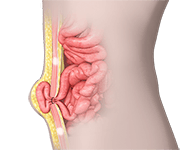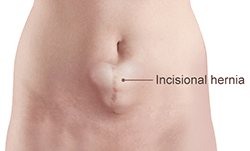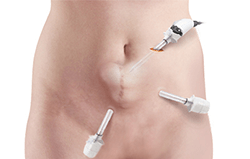Inguinal Hernia

Inguinal hernia is a condition that occurs when the soft tissue from a part of the intestine protrudes out of the abdomen through a tear in the abdominal wall. It is more commonly seen in men than women.
Hernias can be developed during birth, and occur when the abdominal wall fails to close properly. It can also be developed if there is connective tissue degeneration in the abdominal wall causing weakness of muscles due to which pressure builds up in the abdominal wall.
The most commonly observed symptoms of inguinal hernia include severe groin pain (which worsens with coughing or lifting heavy objects), burning, gurgling sensation, nausea and vomiting.
Some of the other factors that worsen hernias are chronic cough, obesity, constipation, pregnancy, poor nutrition, smoking, and stretching or straining abdominal muscles while lifting heavy objects.
Your physician can confirm a hernia by performing a physical examination. Rarely, ultrasound may be needed to look for a hernia.
Treatment
Surgery is the only treatment and is usually performed for hernias that enlarge in size due to increased intra-abdominal pressure, causing intestinal obstruction and restricted blood supply, which may lead to death of bowel tissues.
A hernia repair is usually performed as an outpatient surgery with no overnight stay in the hospital. The operation may be performed as an “open” or “keyhole” (laparoscopic) surgery. Your surgeon will decide which procedure is suitable for the repair and will perform with your consent.
Abdominal wall and incisional/ventral hernias


A variety of abdominal wall hernias can occur, commonly around the umbilical (navel) area or related to previous abdominal surgery. These are usually repaired surgically when there are symptoms such as pain or swelling, and to avoid dangerous complications such as intestinal obstruction.
These hernias are often repaired using a laparoscopic or keyhole approach with the use of mesh. The keyhole repair may assist recovery and reduce post operative pain. Larger ventral hernias which result from previous surgery may require more major surgery to repair the abdominal wall, usually in an open manner and potentially using biologic mesh which can adjust as the patient heals.
Common complications of abdominal wall hernia repair include accumulation of fluid, called seroma, and bruising. These usually both improve with time and rarely may require re-operation. It is imperative to avoid strenuous activity in the early post op period following these repairs (at least 4 weeks) to minimise recurrence and additional complications.
Open Hernia repair
In open hernia repair, a large incision is made on the groin (abdomen) and the bulge is pushed back into place. Surgical procedures for hernia repair include hernioplasty or herniorrhaphy.
- Hernioplasty: This type of procedure is done if the abdominal wall is completely ruptured and damaged. A synthetic mesh is used which is stitched along with the abdominal wall to provide support.
- Herniorrhaphy: This method is done if the abdominal wall is torn and causes leakage of the intestinal contents. Your surgeon opens the wall and pushes the content back into the abdomen and the torn tissue is stitched.
As common with other surgeries, hernia surgery is also associated with certain complications such as local discomfort and stiffness, infection, damage to nerves and blood vessels, bruising, blood clots, wound irritation and urinary retention.
Laparoscopic Hernia Surgery

A hernia is a sac formed out of lining of an organ that comes through the hole or weak area in the wall of a muscle, tissue, or membrane that normally holds an organ in place. Hernias are more common in certain parts of the body such as the abdomen, groin, upper thigh area, and belly button area. They can also occur in any place where you have had an incision from surgery.
A hernia will not get better by itself and may need to be treated surgically as they have a high risk of becoming strangulated. A hernia repair is usually performed as an outpatient surgery with no overnight stay in the hospital. The operation may be performed as an “open” or “keyhole” (laparoscopic) surgery.
In open hernia repair, a large incision is made on the groin (abdomen) and the bulge is pushed back into place. Laparoscopic hernia surgery is a surgical procedure in which a laparoscope is inserted into the abdomen through a small incision. The laparoscope is a small fibre-optic viewing instrument attached with a tiny lens, light source and video camera.
Advantages over an open surgery
- Less post-operative pain with smaller incisions and faster recovery
- No further incisions required for patients with hernias in both groins (bilateral hernia)
- Ideal method for patients with recurrent hernias after previous surgery
- Early discharge from hospital
- Earlier return to work
Laparoscopic surgery is performed in a hospital operating room under general anaesthesia. The television camera attached to the laparoscope displays the image of the abdominal cavity on a television screen. The surgeon makes three small incisions over the abdomen to insert the balloon dissector and trocars (keyholes). A deflated balloon along with the laparoscope is inserted and the balloon is inflated with a hand pump under direct vision. Once the trocars (key holes) are placed, the keyhole instruments are then inserted to repair the hernia. A sheet of mesh is inserted through the top key hole and positioned and fixed in the abdominal wall to reinforce the repair and help prevent recurrent hernias. After completion of the repair the CO2 gas is evacuated and the trocars are removed and the tiny incisions are closed and dressed with a sterile bandage.
Specific complications of laparoscopic hernia surgery may include local discomfort and stiffness, infection, damage to nerves and blood vessels, bruising, blood clots, wound irritation and urinary retention.
Post-Operative Guidelines
- Pain medication will be provided and should be taken as directed
- Remove the bandage after 24 hours
- Swelling in the groin, at the site of hernia may occur due to serum accumulation in the cavity, left by reducing the hernial sac
- Bruising usually appears in the genital area, which is not painful and disappears over 1-2 weeks
- You are able to drive and resume normal activities when comfortable, unless otherwise instructed
- Make a follow up visit 7 to 10 days after surgery to monitor your progress














